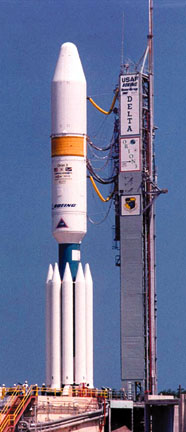- Delta III rocket
Infobox rocket

imsize = 186
caption =A Delta III rocket on the launch pad
name = Delta III
function = Orbitallaunch vehicle
manufacturer =Boeing
country-origin =United States
height = 35 m
alt-height = 114 ft
diameter = 4 m
alt-diameter = 13.1 ft
mass = 301,450 kg
alt-mass = 664,580 lb
stages = 2
LEO-payload = 8,290 kg
alt-LEO = 18,280 lb
payload-location = GTO
payload = 3,810 kg
alt-payload = 8,390 lb
status = Retired
sites = LC-17, Cape Canaveral
launches = 3
success = 0
partial = 1
fail = 2
first=August 27 1998
last=August 23 2000
boosters = 9 Nº
boosterengines = 1GEM 46
boosterthrust = 628.3 kN
alt-boosterthrust = 141,250 lbf
boosterSI = 273 s (2.68 kN·s/kg) (sea level)
boostertime = 75 seconds
boosterfuel = solid
stage1engines =1Rocketdyne RS-27A
stage1thrust =1085.79 kN
alt-stage1thrust = 244,094 lbf
stage1SI =254 s (2.49 kN·s/kg) (sea level)
stage1time =320 seconds
stage1fuel =LOX /kerosene
stage2engines =1Pratt & Whitney RL-10B
stage2thrust =110.03 kN
alt-stage2thrust =24,736 lbf
stage2SI =462 s (4.53 kN·s/kg)
stage2time =700 seconds
stage2fuel =LOX /LH2 The Delta III rocket was an expendablelaunch vehicle made byBoeing . The first Delta III launch was onAugust 26 1998 . Of its three flights, the first two were failures, and the third—which succeeded—carried only a dummy (inert) payload. Delta III had the capability to deliver 8,400 pounds (3,800 kilograms) of cargo togeostationary transfer orbit , twice the payload of its predecessor in the Delta rocket family, the Delta II.History
Throughout the 1990s, satellite masses were growing steadily. It was apparent that the Delta II could not lift many upcoming payloads. In addition, the Delta was a relatively complex launch vehicle, designed for mission flexibility and low development costs rather than low operating cost. Boeing felt the need to maintain market position, through increased capacity, more competitive pricing, and expedited launch-site operations.
The inaugural launch on
26 August 1998 fromCape Canaveral Air Force Station ended in failure, when software adapted from the Delta II caused a guidance failure during first-stage flight. The failure and subsequent vehicle motion depleted the hydraulic fluid used for steering. Upon loss of control, the vehicle was destroyed. The Galaxy X satellite (Hughes HS601 HP type) crashed in the Atlantic Ocean.The second launch on
4 May 1999 , also from Cape Canaveral, also ended in failure. The second stage engine experienced a pressure anomaly and rupture, and shut down while its second burn was underway. The Orion 3 satellite (Hughes HS601 model) was stranded in a useless orbit.The third flight on
23 August 2000 , launched the DM-F3 payload. This was a dummy designed to mimic an HS601 communications satellite, and equipped with sensors to monitor vehicle characteristics. Final orbit was slightly low (20,600 km instead of 26,000), but was considered a success. However, with the combining factors of a declining satellite launch market, low customer confidence following the two consecutive failures, and the advent of Boeing's new Delta IV, this would prove to be the Delta III's final launch.Vehicle description
The Delta III had the kerosene/oxygen first stage of a Delta II. However, the complex and less-efficient stack of upper stages was replaced with a more advanced hydrogen/oxygen stage. The boosters were noticeably larger. The new fairing fit larger payloads; the first stage has been modified to accommodate the larger stack.
The upper stage burned high-performance
cryogenic fuel in a proven Pratt & WhitneyRL-10 engine design. The liquid-hydrogen tank was 4 meters in diameter, covered in insulation derived from that of the Space Shuttle External Tank, and built byMitsubishi Heavy Industries . The separate liquid-oxygen tank retained the 2.4 m diameter of previous Deltas. Both were structurally stable. The RL-10 engine, from the Centaur upper stage, was in the new RL-10B-2 configuration, with an extending nozzle. The nozzle fit in the vehicle stack for launch, then extended in space to increase expansion ratio and improve efficiency. The extending segments were uncooled carbon composites, made by SEP of France.The solid rocket boosters were Alliant GEM-46s, sometimes referred to as GEM LDXL (Large Diameter Extended Length). These were 14.7 meters length and 46 inches diameter, versus 13 meters and 40 inches for the GEMs on Delta II. Six were ignited on the launch pad, three were lit in flight. To maintain steering authority, three of the boosters had vectoring nozzles.
The payload fairing was a new design in
composite material s, matching the upper stage hydrogen tank at 4 meters diameter.To keep the vehicle at a reasonable length and avoid steering problems in high-altitude crosswinds, the first stage was shortened. The kerosene (
RP-1 ) fuel tank, formerly 8 feet in diameter like the liquid oxygen tank, was a squat 4 meters, like the hydrogen tank. It too was made by Mitsubishi Heavy Industries. The new length also minimized changes to the launch tower.In keeping with the 4-digit designation system from the Delta II, the Delta III is technically referred to as the 8930.
Overall, payload to GTO (Geostationary-Transfer Orbit) was doubled versus the Delta II, with reasonable program costs and streamlined operations. However, the consecutive failures of the initial Delta IIIs, combined with the more-advanced Delta IV program and the successful
Sea Launch venture, left the Delta III as an interim vehicle. However, technologies and components from the Delta III contributed to the development of the Delta IV.External links
* [http://www.boeing.com/defense-space/space/delta/delta3/delta3.htm Boeing Delta III page]
* [http://kevinforsyth.net/delta/ History of the Delta Launch Vehicle]
* [http://www.spaceflightnow.com/delta/d280/000821delta.html Spaceflight Now article 8/21/2000]
Wikimedia Foundation. 2010.
